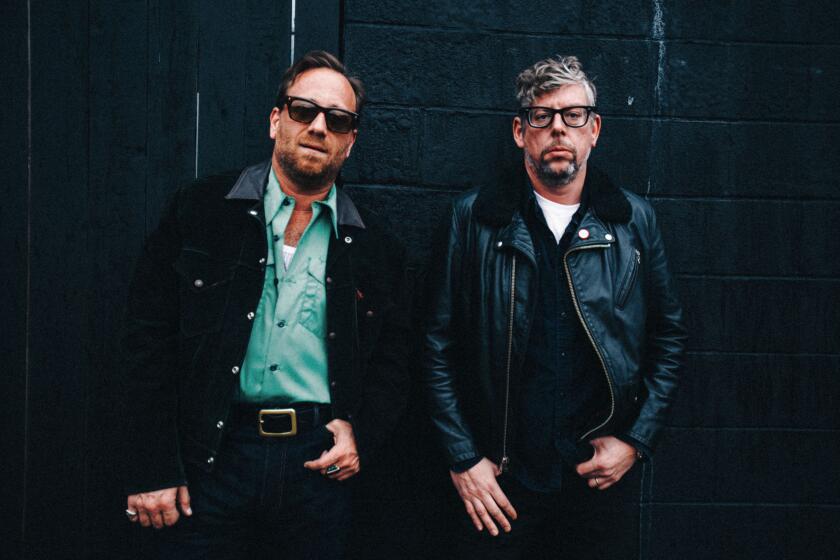A rock discord progression
- Share via
In pop, as in the sporting world that provided a model for the Rock and Roll Hall of Fame, one fan’s dream is another’s disappointment. This is true of the annual artist inductions, which elevate some while ignoring others -- Rush was robbed again! -- and the pattern will repeat Thursday and Friday in New York at the hall’s 25th anniversary concerts.
The shows at Madison Square Garden promise everything a classic rock fan desires. The headliners are U2 and Bruce Springsteen and the E Street Band, rock’s most reliably awe-inducing live acts. Soul legends including Stevie Wonder and Aretha Franklin will collaborate with worthy inheritors including John Legend and Annie Lennox. Heavy ax men Eric Clapton, Jeff Beck and Metallica likely will reach new heights of guitar-face.
For those baby boomers who come to sing along, Simon & Garfunkel and Crosby, Stills and Nash will harmonize with pals including Dion and Bonnie Raitt.
Yet these once-in-a-lifetime shows are missing so much. Where’s the hip-hop? The disco? The funk? The punk? (Proto-punk’s in the house: Lou Reed will perform with Metallica.) Why no Latin music, not even Carlos Santana? Wasn’t Madonna invited?
Madonna might show up, I suppose, in one of the montages sure to be shown during the evening’s intermissions. Her 2008 induction exemplified how the Rock Hall is adapting to a new era, one in which the grand narratives of capitol-R rock ‘n’ roll have given way to a broader understanding of contemporary pop music.
--
Mutual admiration
The Rock Hall was founded as a kind of countercultural Friars Club, in which the titans of the post-Elvis and Little Richard era feted each other at black-tie dinners, which always ended in star-studded jam sessions. It was a flush time for the music industry, and the once scruffy street heroes who’d made rock a viable career seemed happy to join an establishment they could control.
Highlights from these dinners are now vicariously open to all, via “Rock and Roll Hall of Fame Live,” a nine-DVD collection that also features footage from the stadium concert that celebrated the Cleveland museum’s opening in 1995. Viewers will be drawn to these discs for the performances, but the induction speeches are more revealing. The one Mick Jagger gave for the Beatles in 1988 sounds like a wedding toast.
“They had on these beautiful long black leather trenchcoats,” Jagger recalled of the night he first spotted his rivals standing in the back of a club. “I could really die for one of those. And I thought, even if I have to learn to write songs, I’m gonna get this.” Jagger’s impish smile as he said these words showed that, just then, he was less concerned with making history than with getting a laugh out of the room.
Such moments reveal the driving force behind the Rock Hall in its pre-museum days: an interest in tracing personal connections instead of larger cultural shifts. Because its ceremonies revolved around either peers or heirs giving personal testimonies about the artists being inducted, the Rock Hall grew up as a family institution, one that encouraged an understanding of rock music and culture as something passed on from one musician to another.
It took eloquent speakers like Bono and Springsteen to connect the ideas of inheritance with legacy and to argue for the music as both traditional and dynamic. Inducting the Boss in 1999, Bono compared him to Elvis, Brando and Steinbeck, but he also said that his music offered “the first whiff of Scorsese, the first hint of Patti Smith, Elvis Costello and the Clash.”
Honoring U2 in 2005, Springsteen remembered that he discovered the band on a night out with Pete Townshend, “to catch the first whiff of those about to unseat us.”
All this whiff-catching portrays rock’s spirit as something in the air, not necessarily passed from hand to hand, but preserved and adapted by strangers who then become artistic stepchildren. That’s legacy. The shift toward this point of view began when the museum opened in 1995, transforming the Hall from what was essentially a private club into a public institution.
(Full disclosure: I have given talks at the museum several times throughout the years, and when I worked for the Experience Music Project in Seattle, the Rock Hall’s former education director, Robert Santelli, who is now with L.A.’s Grammy Museum, was my boss.)
In 1997, Santelli, then the education director of the fledgling institution, wrote that the task of the Rock Hall’s first curatorial team was twofold: “[N]ot just to preserve rock ‘n’ roll history, but to identify it. The curatorial team attempted to build a rock and roll historiography, one that would create a basic foundation from which future discourse on the music could be launched.”
He was using curatorial lingo to say something Rock Hall haters should be happy to acknowledge: At least since it took on the larger project of archiving and interpreting pop history since the rock era, this is an institution whose primary purpose is to cause arguments.
--
Quarrelphenia
In the 1980s, arguments about the Rock Hall reflected many people’s discomfort with the insider mood of those dinners and the idea that pop music (and especially rock) could support an elite at all. The squabbles shifted in tone in the 1990s. The idea of authenticity was big then, as punk, hip-hop and indie rock rose in influence; so was the romance of the rock underground.
To many, the Rock Hall came to represent corporate excess, especially after its museum’s five-hour opening concert in Cleveland’s Municipal Stadium with an overstuffed lineup featuring young mainstream stars such as Bon Jovi and Sheryl Crow seemed antithetical to the notion of rock as a grassroots art form.
Today, the arguments have shifted again. Pop has replaced rock as the ruling force within contemporary music, and instead of seeming inauthentic, the Rock Hall appears too focused on authenticity. Pop is all about mixed-up fun -- it’s multicultural, global and novelty-obsessed. (It’s also feminine, and its return to dominance makes one long for more female voices and faces in the Hall.) Its champions don’t care much about tracing the legitimacy of inheritance. They open their arms to every stray sound and shiny star.
This weekend’s concerts, with their heavy focus on 1960s countercultural icons and arena rockers, might be great, but they seem old-fashioned. After all, this year’s Rock Hall nominees include ABBA -- to many, the cheesy Nordic antithesis of acts the Rock Hall was established to celebrate. But that’s how inheritance expands into legacy. And it’s also a case of what goes around comes around.
When the Beatles were inducted, Ringo Starr responded to that gentle ribbing from Jagger with a zinger of his own. “The Rock and Roll Hall of Fame,” he said from behind his aviator shades. “I love it. They always called us a pop group!”
If he hadn’t been grinning so widely, one might have thought he was trying to start an argument.
--
More to Read
The biggest entertainment stories
Get our big stories about Hollywood, film, television, music, arts, culture and more right in your inbox as soon as they publish.
You may occasionally receive promotional content from the Los Angeles Times.










